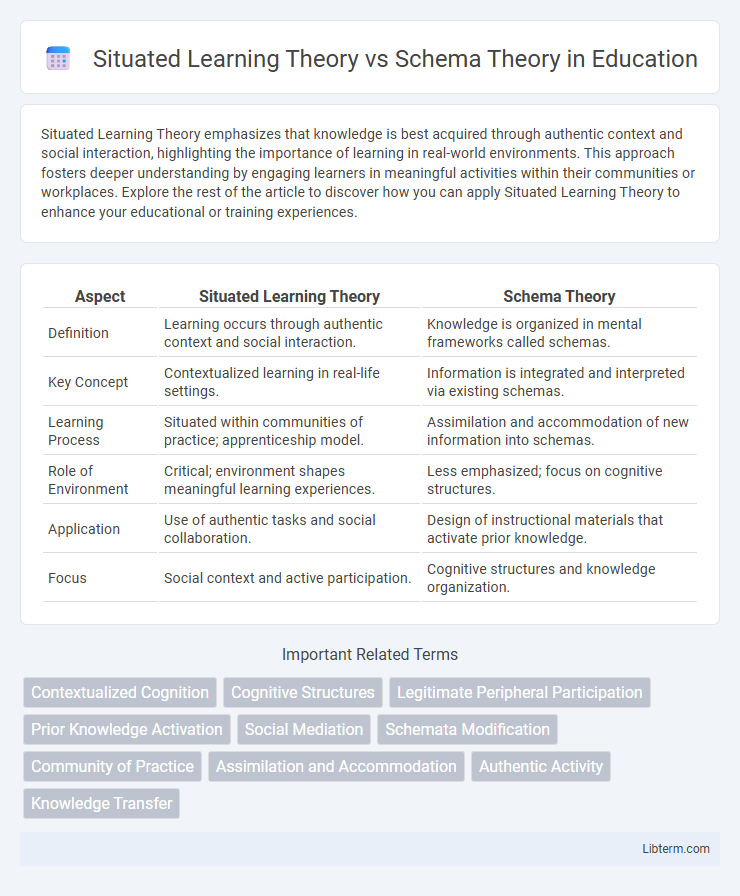Situated Learning Theory emphasizes that knowledge is best acquired through authentic context and social interaction, highlighting the importance of learning in real-world environments. This approach fosters deeper understanding by engaging learners in meaningful activities within their communities or workplaces. Explore the rest of the article to discover how you can apply Situated Learning Theory to enhance your educational or training experiences.
Table of Comparison
| Aspect | Situated Learning Theory | Schema Theory |
|---|---|---|
| Definition | Learning occurs through authentic context and social interaction. | Knowledge is organized in mental frameworks called schemas. |
| Key Concept | Contextualized learning in real-life settings. | Information is integrated and interpreted via existing schemas. |
| Learning Process | Situated within communities of practice; apprenticeship model. | Assimilation and accommodation of new information into schemas. |
| Role of Environment | Critical; environment shapes meaningful learning experiences. | Less emphasized; focus on cognitive structures. |
| Application | Use of authentic tasks and social collaboration. | Design of instructional materials that activate prior knowledge. |
| Focus | Social context and active participation. | Cognitive structures and knowledge organization. |
Introduction to Situated Learning Theory
Situated Learning Theory emphasizes learning through authentic context and social interaction, where knowledge is co-constructed within communities of practice. This approach contrasts with Schema Theory, which focuses on cognitive structures and mental frameworks used to organize and interpret information. Situated Learning Theory highlights the importance of immersion in real-world environments to facilitate meaningful learning and skill acquisition.
Introduction to Schema Theory
Schema Theory explains how knowledge is organized into mental structures called schemas that influence perception, comprehension, and memory. These cognitive frameworks help individuals interpret new information by linking it to existing knowledge, facilitating learning and problem-solving. It contrasts with Situated Learning Theory, which emphasizes learning within authentic contexts and social interactions, highlighting the role of environment over internal mental models.
Core Principles of Situated Learning
Situated Learning Theory emphasizes learning through authentic contexts and social interaction, where knowledge is co-constructed within a community of practice. Core principles include legitimate peripheral participation, where novices gradually engage in real-world activities alongside experts, fostering deeper understanding. This contrasts with Schema Theory, which focuses on cognitive frameworks organizing knowledge but does not inherently involve social or contextual learning environments.
Fundamental Concepts of Schema Theory
Schema Theory centers on the idea that knowledge is organized into mental structures called schemas, which help individuals interpret and encode new information based on prior experiences. These schemas are dynamically adapted through assimilation and accommodation processes, allowing learners to integrate or modify existing knowledge frameworks. Unlike Situated Learning Theory, which emphasizes learning context and social interaction, Schema Theory focuses on cognitive organization and how mental frameworks guide understanding and memory.
Key Differences Between the Theories
Situated Learning Theory emphasizes knowledge acquisition through authentic context and social interaction, highlighting the importance of participation in real-world activities. In contrast, Schema Theory centers on the cognitive framework used to organize and interpret information, focusing on how existing mental structures influence learning and memory. Key differences lie in Situated Learning's focus on contextual experience and social collaboration versus Schema Theory's emphasis on internal mental models and information processing.
Learning Context: Real-life vs Cognitive Structures
Situated Learning Theory emphasizes learning within authentic real-life contexts, where knowledge is acquired through social interaction and practical engagement in relevant environments. Schema Theory focuses on cognitive structures, describing how prior knowledge frameworks are organized and used to interpret new information. While Situated Learning bridges knowledge and practice through context-specific experiences, Schema Theory underscores the mental organization that shapes understanding across various contexts.
Implications for Educational Practice
Situated Learning Theory emphasizes learning through authentic contexts and social interaction, encouraging educators to create real-world, collaborative problem-solving scenarios that enhance knowledge transfer. Schema Theory highlights the importance of activating and building upon learners' existing mental frameworks, guiding teachers to structure instruction that connects new information with prior knowledge for better comprehension and retention. Combining these approaches, educators can design learning experiences that are both contextually relevant and cognitively meaningful, improving student engagement and mastery.
Strengths and Limitations of Situated Learning
Situated Learning Theory excels in promoting authentic context-based learning, fostering deeper understanding and skill transfer by embedding knowledge within real-life situations. Its limitation lies in the dependency on specific contexts, which may reduce the applicability of learned skills in unfamiliar environments. Unlike Schema Theory, which highlights mental structures for organizing information, Situated Learning emphasizes social interaction and practical engagement but may struggle with abstract concept generalization.
Strengths and Limitations of Schema Theory
Schema Theory excels in explaining how prior knowledge influences comprehension and memory by organizing information into mental frameworks, enhancing learning efficiency and recall accuracy. It faces limitations in addressing the dynamic and context-dependent nature of knowledge construction, as schemas can lead to misconceptions or biases when encountering new information. Unlike Situated Learning Theory, which emphasizes learning through authentic contexts and social interaction, Schema Theory focuses primarily on internal cognitive structures, potentially overlooking the environmental and situational factors crucial for deep understanding.
Choosing the Right Theory for Learning Environments
Situated Learning Theory emphasizes learning through authentic contexts and social interaction, making it ideal for environments requiring practical application and collaboration. Schema Theory focuses on organizing knowledge into mental frameworks, benefiting settings where structured information and prior knowledge integration are essential. Selecting the right theory depends on whether learning goals prioritize contextual experience and social engagement or cognitive organization and schema development.
Situated Learning Theory Infographic

 libterm.com
libterm.com